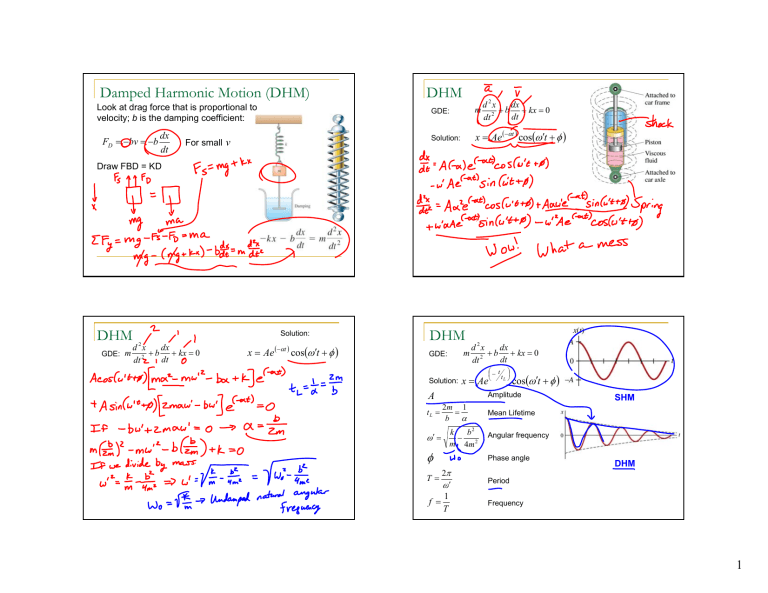Damped Harmonic Motion (DHM) DHM DHM DHM
advertisement

Damped Harmonic Motion (DHM) Look at drag force that is proportional to velocity; b is the damping coefficient: FD = −bv = −b dx dt For small v DHM d 2x dx + b + kx = 0 dt dt 2 GDE: m Solution: x = Ae (−αt ) cos(ω ′t + φ ) Draw FBD = KD DHM Solution: d x dx + kx = 0 GDE: m 2 + b dt dt 2 x = Ae (−αt ) cos(ω ′t + φ ) DHM d 2x dx + b + kx = 0 dt dt 2 GDE: m Solution: x = Ae⎝ ⎛− t ⎞ ⎜ t L ⎟⎠ cos(ω ′t + φ ) A Amplitude 2m 1 tL = = b α Mean Lifetime k b2 − m 4m 2 ω′ = φ f = Angular frequency Phase angle 2π T= ω′ 1 T SHM DHM Period Frequency 1 A mass on a spring with a natural angular frequency ωo = 3.6 rad/s is placed in an environment in which there is a damping force proportional to the speed of the mass. If the amplitude is reduced to 0.35 times its initial value in 12.9 s, what is the angular frequency of the damped motion? A harmonic oscillator starts with an amplitude of 20.0 cm. After 10.0 s, the amplitude decreases to 15.0 cm. If the linear damping coefficient is 2.00 N-s/m, how much mass is oscillating? Values of Damping Forced Vibration ⎛− t ⎞ ⎜ t L ⎟⎠ x = Ae⎝ k b2 − ω′ = m 4m 2 cos(ω ′t + φ ) There is a oscillating force that is driving the harmonic motion of the system. DHM Angular frequency When , This is critical damping, and the value of b for which this occurs is bc: When b > bc, overdamped When b < bc, underdamped = Fo cos(ω t ) 2 Forced Vibration GDE: d 2x dx m 2 + b + kx = F0 cos(ω t ) dt dt Solution: x = A sin (ωt + φ ) Forced Vibration Solution: x = A sin (ωt + φ ) d 2x dx m 2 + b + kx = F0 cos(ω t ) dt dt GDE: (k − mω )A sin(ωt + φ ) + ωbA cos(ωt + φ ) − F cos(ω t ) = 0 2 0 Use: cos(ωt + φ ) = cos(ωt ) cos(φ ) − sin (ωt )sin (φ ), sin (ωt + φ ) = sin (ωt ) cos(φ ) + cos(ωt )sin (φ ) [(k − mω )A sin(φ ) + ωbA cos(φ ) − F ]cos(ωt ) + [(k − mω )A cos(φ ) − ωbA sin (φ )]sin (ωt ) = 0 2 0 2 A Amplitude ω Angular frequency φ ⇒ Phase angle and = Fo cos(ω t ) Forced Vibration d 2x dx + b + kx = F0 cos(ω t ) dt 2 dt GDE: m Solution: x = A sin (ωt + φ ) tan (φ ) = Resonance [(k − mω )A cos(φ ) + ωbA sin(φ )] = 0, ⇒ 2 [(k − mω )A sin (φ ) + ωbA cos(φ ) − F ] = 0 tan (φ ) = k ωo2 − ω 2 , ωo = mωb m 2 0 ∴ A= ( Fo m 2 ω 2 − ωo2 ) 2 + b 2ω 2 A 3.0-kg mass is attached to a spring with a force constant of 48 N/m. The motion is subject to a damping force F =-bv, where b = 4.0 kg/s. The mass is subjected to an oscillating force with a driving frequency ω. At what value of ω will the oscillations have their maximum amplitude? k ωo2 − ω 2 , ωo = mωb m = Fo cos(ω t ) Tacoma Narrows Bridge 3



